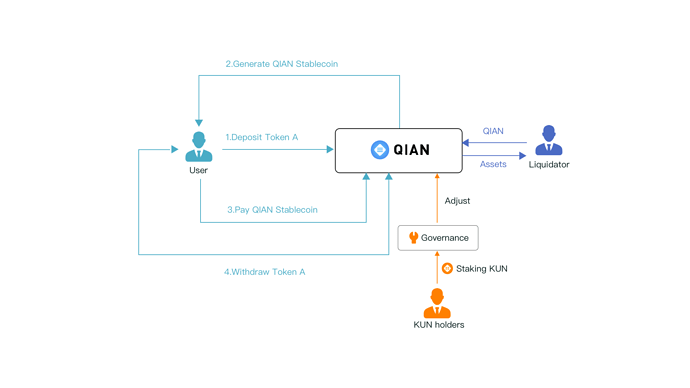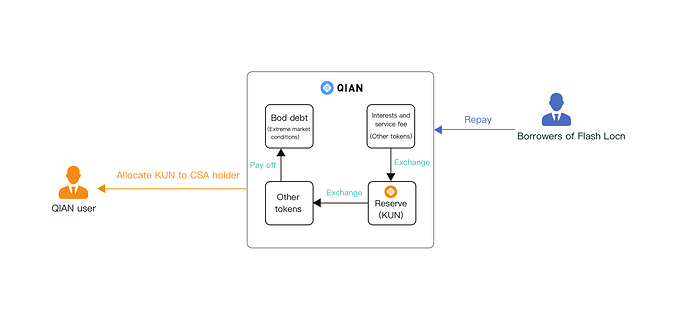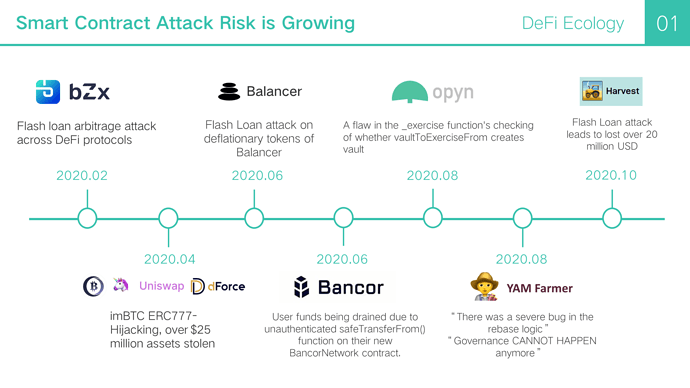 Some people say that the future trend of blockchain will still be in the DeFi area of decentralized exchange and stable currency.
Some people say that the future trend of blockchain will still be in the DeFi area of decentralized exchange and stable currency.
USDT has been the top stability currency for many years, and doubts about its extreme centralization have not diminished as USDT usage has increased.Arbitrary issuance, financial opacity, lack of an open and transparent operating mechanism, and market manipulation have become fatal factors limiting its development. The stabilization currency is one of the troika of DeFi ecology.The rise of DeFi this year has raised the prospect of decentralised stabilisers, led by DAI, which are emerging in the cryptocurrency market.
anyone can issue a stable currency" as the core of QIAN stable currency agreement with centralized USDT stable currency and decentralized stable currency DAI advantages of the two, in reference to subscribe mechanism adopted by the peg has made the appropriate adjustment and on the basis of risk control, make out a set of encryption type currency reserves stable currency agreement.
This stabilisation currency agreement incorporates DeFi, Lightning Loan, LP Mining and other hottest elements of the year.
On December 2, 2020, CoinEx and QIAN reached an agreement to launch the KUN/USDT market, and to celebrate the simultaneous launch of KUN online, CoinEx initiated a welfare campaign to share refunds with 40000KUN.
KUN is a QUSD governance token based on QIAN's stability currency agreement, which is used to vote for QIAN's ecological governance and maintain QUSD price stability.
On December 9th,David, founder and architect of the QIAN Stability Coin agreement, was invited to share with the community what QIAN has to say about CoinEx's new AMA column "Please Speak C"
The following is the transcript of AMA:
 1. Let’s start with an easy question. As we are all curious, this project has an interesting name, QIAN. So why did you give it such a name? Is there some meaning behind it?
1. Let’s start with an easy question. As we are all curious, this project has an interesting name, QIAN. So why did you give it such a name? Is there some meaning behind it?
Yes,there is a special meaning of QIAN, as we said in the WhitePaper:QIAN represents the universe and money. In the "Eastern Holy Bible: I Ching", the "Hexagram Qian" represents the sky, the law of everything in the universe, which has the most positive energy and spirit.
Based on this spirit, we named the first fully community-driven decentralized stablecoin protocol to be QIAN. And we hope that the great traditional culture of China can be understood around the world, and more cryptocurrency holders could be fans of traditional Chinese culture.
 2. As the governance token of QUSD, what role does KUN play in the entire QIAN stablecoin protocol? How can community participants obtain KUN? How about its value capture ability?
2. As the governance token of QUSD, what role does KUN play in the entire QIAN stablecoin protocol? How can community participants obtain KUN? How about its value capture ability?
The above charts showing the role of $KUN token in the QIAN stablecoin protocol. $KUN is the governance token of the QIAN protocol, used to vote on QIAN community governance and maintain $QUSD's price stability. As a governance token, $KUN modifies the key parameters of the QIAN protocol and controls the decision of community operation through voting.
Community users can get $QUSD by minting, participating in liquidity mining, join $KUN governance mining, etc., or can directly buy it with $USDT at CoinEx.
$QUSD will introduce a stablecoin Flash Loan service and will use the Flash Loan income to buy $KUN in the market and keep it as a reserve. $KUN will also be burned through NFT tokens interaction and other ways to reduce the number of circulation.
The DeFi project $AAVE just announced that their Flash Loan business exceeded $1 billion, and their charge fee is 9/10,000 each lending, which is a considerable income. Therefore, in the long view, $KUN can have a strong backup through flash loan business.
 3. Before it was launched on CoinEx, KUN already had trading pairs available in decentralized protocols such as Balancer and UniSwap. What made you choose the centralized exchange CoinEx as a partner this time? After KUN is listed on CoinEx, what are the benefits for community users?
3. Before it was launched on CoinEx, KUN already had trading pairs available in decentralized protocols such as Balancer and UniSwap. What made you choose the centralized exchange CoinEx as a partner this time? After KUN is listed on CoinEx, what are the benefits for community users?
The QIAN stablecoin protocol is a decentralized, community-driven DeFi project. About listing issues, we will always choose the exchange that has the same community culture with QIAN, we focus on transparency, and the exchange partner should meet the long-term development needs of the QIAN community.
After communication, we are very happy to find that CoinEx meets the QIAN community standards in terms of global influence, product quality, operational transparency and compliance, and both of us are also highly compatible in the concept of community development. Therefore, QIAN governance token $KUN chose to get listed on CoinEx, and carried out events such as deposit, trading competitions, and airdrops.
Here is the event link: https://announcement.coinex.com/hc/articles/360053167651, a total of 50,000 $KUN tokens for everyone to share, welcome to get $KUN!
 4. As we know, the generation of QUSD is a process of implementing the "currency swap agreement (CSA)" between users and smart contracts, so stablecoin minters need to lock in mainstream digital assets such as ETH and BTC to QIAN smart contracts before they can get the anchored QUSD stablecoin. Under unilateral market conditions, CSA holders may face collateral liquidation issues like in the case of MakerDAO. So what are the privileges for CSA holders? How can CSA holders create benefits for themselves?
4. As we know, the generation of QUSD is a process of implementing the "currency swap agreement (CSA)" between users and smart contracts, so stablecoin minters need to lock in mainstream digital assets such as ETH and BTC to QIAN smart contracts before they can get the anchored QUSD stablecoin. Under unilateral market conditions, CSA holders may face collateral liquidation issues like in the case of MakerDAO. So what are the privileges for CSA holders? How can CSA holders create benefits for themselves?
"Currency Swap Agreement (CSA)" like the CDP mechanism of MakerDAO. Users only need to lock the excess tokens into QUSD's smart contract without paying any interest. So don't call it lending but a currency swap agreement is better. CSA of QIAN stablecoins are considered as a proof of currency swap between the smart contract and the cryptocurrency holder, this is the reason that we name the smart contract under this mechanism CSA —— Currency Swap Agreement.
As a CSA holder, you can generate $QUSD stablecoins within the quota range. In order to encourage everyone to mint $QUSD, the QIAN project has launched a six-month minting and mining reward events starting on October 23, 2020. Minters who only need to mint $QUSD can get $KUN according to the types of minted assets and the amount of $QUSD generated.
As a CSA holder, you can also arbitrage through liquidity mining and $QUSD transaction except minting. At present, you can start liquidity mining of $QUSD through the two entrances https://qian.finance/mining-eth and https://bsc.qian.finance/mining-bsc, corresponding to the Ethereum and BSC networks respectively. We encourage everyone who uses $QUSD to actively get involved in liquid mining to enrich the ecology of $QUSD and get mining rewards at the same time.
 5. The charm of DeFi lies in its decentralized characteristics that can improve transaction efficiency while ensuring that each step is open and transparent. Although the private key is in the hands of individuals, asset security can also be guaranteed. This June, however, constant hacker thefts amid the DeFi boom have once again warned investors of the security risks facing DeFi smart contracts. What will you do to ensure the safety of users' assets locked in QIAN smart contracts?
5. The charm of DeFi lies in its decentralized characteristics that can improve transaction efficiency while ensuring that each step is open and transparent. Although the private key is in the hands of individuals, asset security can also be guaranteed. This June, however, constant hacker thefts amid the DeFi boom have once again warned investors of the security risks facing DeFi smart contracts. What will you do to ensure the safety of users' assets locked in QIAN smart contracts?
This picture shows the major DeFi security accidents of this year. Unlike ordinary DeFi applications, the base layer of the QIAN stablecoin protocol uses two core technical architectures: APEC, an extended component BEAMS. The ultimate goal is to make the QIAN protocol be close to the development iteration speed and user experience of traditional Internet products, while retaining their security features.
The picture above shows the BEAMS system, which includes three core components: global emergency lockdown, the GEL, cooperative automatic lockdown CALM, and multi-signature management key MAK.
If there is a problem with the contract, GEL can manually or automatically trigger the emergency lockdown, stop all inbound and outbound calls, and protect the security of the assets locked in the contract.
QIAN adopts bank-level risk control standards, uses an independent high-availability master-slave hot standby cluster, and operates 7x24 hours a day. CALM checks the status of the contract every 5 seconds and performs strict accounting and reconciliation of all financial assets in the contract.
In order to avoid the risk of a single management key being lost or the key owner maliciously attacks the system, the smart contract of the QIAN stablecoin protocol uses a multi-signature mechanism. Currently, We choose the 3-2 multi-signatures , and as the platform's locked assets increase, it will gradually increase to 5-3 or even 7-5 multi-signature mechanisms.
Through the above active/passive defense measures, the QIAN protocol can protect the security of users' locked assets to the maximum extent.
 6. Community governance is another important link for DeFi projects. What is the governance model in this 100% community-based project? How to mobilize community members to take an active part in community governance?
6. Community governance is another important link for DeFi projects. What is the governance model in this 100% community-based project? How to mobilize community members to take an active part in community governance?
QIAN has carried out a lot of preliminary work on the consensus build-up of the community, including each round of liquidity mining settings, collateral assets settings, etc. Each major decision is finally made through goverance voting after full discussion in the community.
QIAN has published a relatively complete community governance agreement. Everyone is fully aware that community governance is not a simple matter in practice, but The project sponsors, core developers, and community enthusiasts are persevering in their tasks.
An excellent DeFi project must have excellent community governance. Next, the QIAN community will have the governance committee works to form a volunteer system, unite a group of outstanding community developers, and bring in more external funds to build $KUN's value consensus. All in all, QIAN's community governance will continue to unswervingly promote, and become an excellent DAO governance project in the DeFi world.
 7. Let's talk about another issue that concerns the community. What is QIAN's future development plan?
7. Let's talk about another issue that concerns the community. What is QIAN's future development plan?
As a stablecoin asset, QIAN will increase the usage scenarios of $QUSD in the next step, and at the same time, through the combination of Flash Loan and high-quality ecology collaboration such as $YFII. At present, $KUN mining strategy is also going to join the $YFII Vault.
In addition to DeFi, QIAN will further explore the cooperation with the needs of the $BTC, $ETH miners to expand the usage scenarios of $QUSD; it is also planning to use $QUSD in the transaction of NFT tokens. In short, there are a lot of things that QIAN needs to do in the future. QIAN needs more outstanding talents to join the QIAN community to build community consensus together.
 8. Last but not the least is a popular topic recently. In your opinion, how will Ethereum 2.0 influence the development of DeFi?
8. Last but not the least is a popular topic recently. In your opinion, how will Ethereum 2.0 influence the development of DeFi?
According to the technical architecture of Ethereum 2.0, in the 2.0 era, the Ethereum network will create a group of shards. Sharding is a method used by Ethereum 2.0 to expand the network performance to meet growing user demand. Its work is similar to cutting blockchain into small segments.
In Ethereum 2.0, judging from the aspects of composability, efficiency, total assets, etc, all DeFi applications will eventually be on a single shard, and they will gather together to form a huge, crowded "DeFi City", it is certain that the transaction volume, the number of DApps, and the number of users of the DeFi shard will far exceed other Ethereum shards.
Therefore, in the era of Ethereum 2.0, DeFi DApps will not have to worry about other Ethereum operations occupying their own computing resources. It can be predicted that the gas consumption of DeFi DApps will be lower than it is now, and the speed will be improved. By then, DeFi will be in a real natural trend of the digital world, I'm looking forward to the arrival of Ethereum 2.0.



